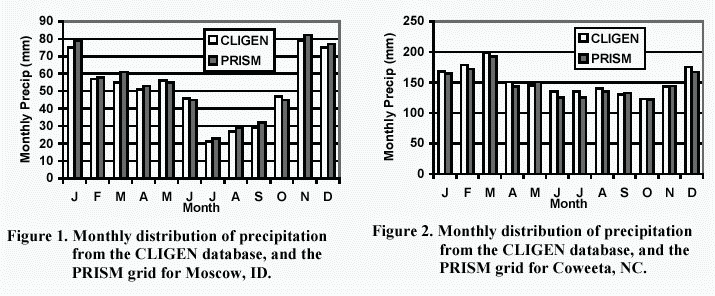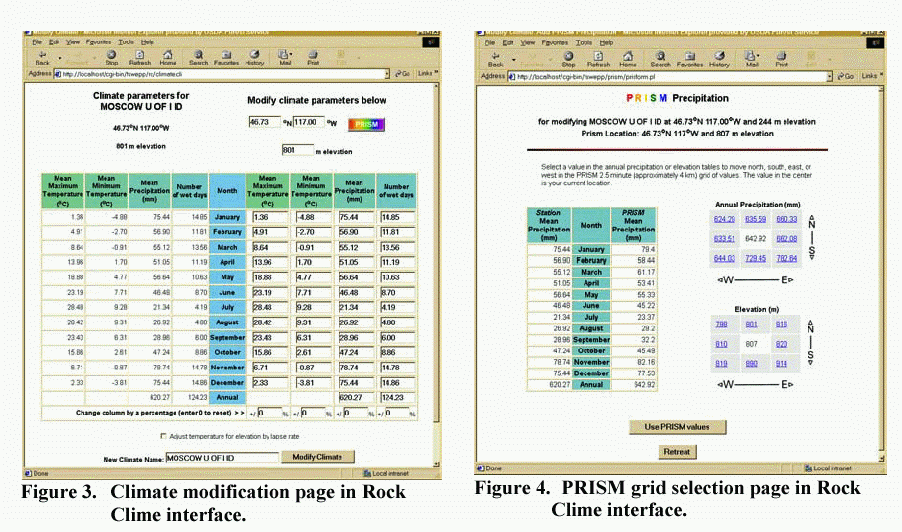
| USDA Forest Service | Rocky Mountain Research Station | Moscow FSL | Soil and Water Engineering |
|---|
 |
Enhancements to the CLIGEN Weather Generator for Mountainous or Custom ApplicationsD. L. Scheele, W. J. Elliot, D. E. Hall |
Abstract
The Water Erosion Prediction Project (WEPP) model is a state-of-the-art soil erosion model applicable to a wide range of vegetation, soil, and climatic conditions. The CLIGEN weather generator is distributed with WEPP. The CLIGEN database contained some errors in the data and did not include many climate stations in mountainous areas where most forests are located and where climate is highly variable. Errors in the database were identified and corrected. The database was expanded from 1,100 stations to more than 2,600. In addition, the ability to modify the statistics for a climate station has been developed to allow users to enter their own weather station statistics into a web-based computer interface. Users can enter specific values, change existing values by a percentage, modify the annual amount, or adjust temperatures with elevation. The PRISM monthly precipitation database was incorporated into the interface to aid users in predicting climates at remote sites. The designated changes are made to an existing CLIGEN parameter file to generate a modified climate file. The modified climate file may be selected for use with a Forest Service WEPP interface, or it may be used to generate a climate file for use with the WEPP model. The enhancements can be accessed from a web site.Keywords: WEPP, CLIGEN, Climate generation, PRISM, Stochastic weather generator.
Authors
Dayna L. Scheele, Civil Engineer, USDA Forest Service, Rocky Mountain Research Station, Moscow, Idaho.
William J. Elliot, Project Leader, USDA Forest Service, Rocky Mountain Research Station, Moscow, Idaho.
David E. Hall, Computer Specialist, USDA Forest Service, Rocky Mountain Research Station, Moscow, Idaho.
The Water Erosion Prediction Project (WEPP) model is a process-based soil erosion model developed to replace the Universal Soil Loss Equation. WEPP requires a daily climate input to drive the plant growth, hydrologic, and soil erosion routines (Flanagan and Livingston 1995). A daily stochastic weather generator, CLIGEN, is packaged with WEPP. Accompanying CLIGEN is a database of weather statistics for about 1100 climates, one for every 60-mile grid across the U.S. (Nicks et al. 1995).
The 60-mile grid of climates was acceptable for areas in the central U.S. where there are minimal differences in weather from one station to the next. In mountainous areas, however, the database was inadequate. Precipitation and temperatures vary considerably with elevation and aspect. Most weather stations in the CLIGEN database were located in valleys, and so gave unacceptably dry and warm climates for nearby mountainous areas. WEPP users sometimes want to incorporate the weather at the remote site with records from SNOTEL stations or data collected as part of other short-term studies.
Another problem with the CLIGEN generator was encountered during some WEPP runs in which a generated climate file predicted more than 999.9 mm of precipitation in a single day, for a climate with an annual precipitation of about 500 mm. The source of this error was a precipitation skew coefficient value that was about 4 times the amount of most skew coefficients in the input statistics data set.
While the above problems were being identified, we were developing a new suite of Internet-based interfaces for WEPP to help users predict soil erosion from roads, forests, and rangelands (Elliot et al. 2000). Included with those interfaces was the need to develop a complementary climate generator interface.
In 1999, Oregon State University, in cooperation with the Natural Resource Conservation Service and numerous state climatologists, released the PRISM database of monthly precipitation values for a 2.5 min (4 km) grid covering the continental U.S. (Daly et al. 1997). The PRISM database, with monthly precipitation estimates for more than 900,000 locations, could enhance the CLIGEN database.
The objectives of this paper are to:
Equation 1 can be solved for any of the three variables, so if two are known or assumed, the third can be calculated. As the CLIGEN parameter file requires P(W|W) and P(W|D), and the user provides only P(W), some assumptions were necessary about the relationship between P(W|W) and P(W|D). Geng et al. (1986) have recommended using:
P(W) = P(W) P(W|W) + (1 - P(W)) P(W|D) (1)
so
P(W|D) = 0.75 P(W) (2)
However, the result of using these two equations is a value of P(W/W) always greater than 0.25, which from the CLIGEN data set is not always true, especially in the drier climates. Other attempts to fix the value for either P(W|W) or P(W|D) were found to be unsatisfactory as the values could result in negative probabilities in drier climates, or probabilities greater than one in wetter climates. To overcome these problems, the ratio of P(W|D):P(W|W) was determined from the nearby CLIGEN parameter file, and that ratio combined with the user's value for P(W) to derive P(W|W) and P(W|D) for the desired climate. Substituting Ratio for P(W|D)/P(W|W) in equation 1 and rearranging then gives:
P(W|W) = 0.25 + P(W|D)) (3)
and
P(W|W) = 1/(1 - Ratio + (Ratio / P(W))) (4)
The new interface incorporates the option to modify temperatures by lapse rate. The lapse rates were specified as 6oC/km for maximum temperature and 5oC/km for minimum temperature. These values are comparable to 4.8 to 6.8oC/km found by Johnson et al. (1998) and the average 6oC/km given by Trewartha and Horn (1980). Generally, minimum temperature lapse rates are not as great as maximum rates because of temperature inversions that can occur during the evenings or during very cold winter days.
P(W|D) = P(W|W) * Ratio (5)


Scheele, D.L; Elliot, W.J.; Hall, D.E. 2001. Enhancements to the CLIGEN Weather Generator for Mountainous or Custom Applications. In: J.C. Ascough II and D.C. Flanagan, eds., Soil Erosion Research for the 21st Century, Proc. Int. Symp. (3-5 January 2001, Honolulu, HI, USA). St. Joseph, MI: ASAE. pp. 392-395